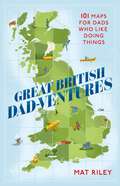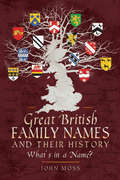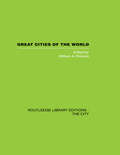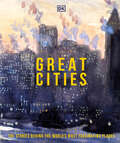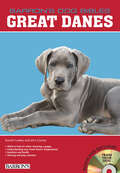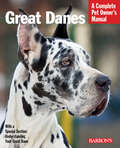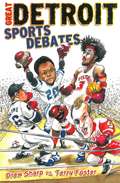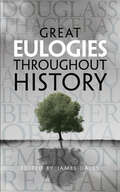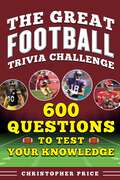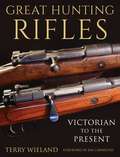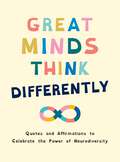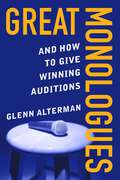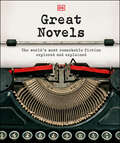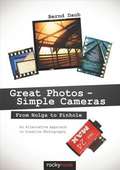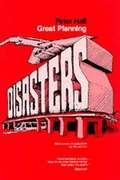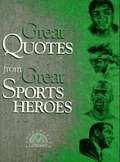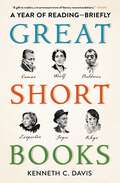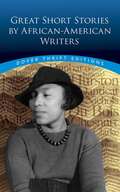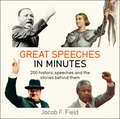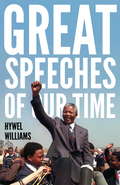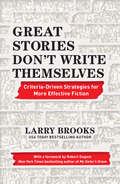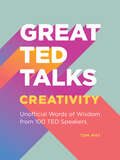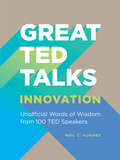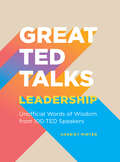- Table View
- List View
Great British Dad-ventures: 101 maps for dads who like doing things
by Mat RileyWATERSTONES' BEST BOOKS OF THE YEAR 2023: NATURE AND TRAVELWhen you're stuck for a great gift for Dad, look no further than GREAT BRITISH DADVENTURES: the ultimate guide to helping Dad discover adrenaline-inducing, mind-expanding or stomach-pleasing mini or big adventures around the British Isles - and families of all ages can join in the fun too!Using maps of all the Scottish and English counties and the Welsh principal areas, the book pinpoints almost 1,000 destinations and activities, including plenty of free and baby-friendly options (and a few that are for Dad's friends only). Whether he's looking for something interesting to do nearby at the weekend or heading off on holiday around our vast and varied British Isles, GREAT BRITISH DAD-VENTURES has all the inspiration Dad needs to get off his screen and do something exciting. Activities include: - walks, hikes, cycling and mountain biking - castles and museums - watersports, wild swimming and boat trips - nature reserves and safari parks - orienteering and bushcraft experiences - scenic driving routes and walking tours - climbing, coasteering and gorge walking - brewery and vineyard tours - and plenty of activities that are unique to the local areas.
Great British Family Names and Their History: What's in a Name?
by John MossA reference guide to hundreds of surnames that reveal the story of the United Kingdom across generations and centuries. To some extent, we are all products of our family history, the many generations before us. So it is with nations. The history of Great Britain has been largely defined by powerful and influential families, many of whose names came down from Celtic, Danish, Saxon or Norman ancestors. Their family names fill the pages of history books, indelibly written into events we learn about at school. Family names like Wellington, Nelson, Shakespeare, Cromwell, Constable, De Montfort, and Montgomery reflect the long, checkered history of Britain, and demonstrate the assimilation of the many cultures and languages that have migrated to the British isles over the centuries. This book is a snapshot of several hundred such family names and delves into their beginnings and derivations, making extensive use of old sources, including translations of The Domesday Book and The Anglo-Saxon Chronicles, as well as tracing many through the centuries to the present day.
Great Cities of the World: Their government, Politics and Planning
by William A. RobsonThe giant city of today is a unique phenomenon. Never before have such acute problems of government, the provision of essential services, planning, social life, and civilized living arisen from uncontrolled urbanization. In the West and in the East, in the more developed and in the less developed countries, in capitalist and communist states, the great metropolis represents a problem of the first importance which challenges the statesman, the official, the town planner, the political scientist, the sociologist and, above all, the intelligent citizen. The editor has here assembled an authoritative series of studies describing the growth, significance, government, politics adn planning of twenty-four great cities of the world. They show how these widely scattered cities faced essentially similar problems. Each study deals with the actual working of one city in the 1950s, how its elective adn executive bodies are organized, the kind of political forces which motivate their activities, the scope and character of the municipal services, how they are finiance. The cities dealt with include Bombay, Amsterdam, Moscow, Montreal, Stockholm, Rome, New York, London, Sydney and Tokyo. This book was first published in 1954.
Great Cities: Their History and Culture (DK History Changers)
by DKExplore the social and cultural history of 100 of the world&’s most important cities. This illustrated history book provides a fascinating insight into the events, movements, and people throughout history who have shaped the cities where we live. Written in a &“biography&” format, it offers a rich historical overview of each featured city, brought to vivid life with beautiful imagery. Inside the pages of this visual guide, discover: • The story behind each city — how it was established, critical moments in its development and why it is considered historically significant. • The different types of cities, from the centers of ancient and lost civilizations and great river cities to planned cities and modern metropolises. • Beautiful illustrations with large-scale reproductions of paintings, photographs, maps and other artifacts. • Stunning images of city life and key moments in history are complemented by close-ups of revealing details and feature panels that provide additional context. From the ancient to the modern, get under the skin of what made cities like Persepolis, Paris, Vienna, Prague, Amsterdam, Tokyo and Dubai tick. This lavish book is about more than history — it explores the art, architecture, commerce and politics of the great civilizations throughout history. Great Cities provides a unique window into how cities have become markers of human progress. Explore which ancient civilization founded the precursor to Mexico City, why Venice was the gateway to the East, what the Belle Epoque was and which city was the first to build sewers. It&’s the perfect gift for armchair explorers interested in history, geography and the arts.
Great Danes (B.E.S. Dog Bibles Series)
by Rachel Cawley John CawleyThe must-have resource to care for, train, and keep your Great Dane happy and healthy!At a glance Great Danes can appear intimidating, but underneath that huge stature is a family-friendly and good-natured friend for life! But due to their size, good training is a must. This Great Dane bible contains veterinarian approved advice and information on care and puppy training. This thorough dog breed book contains highly-detailed but accessible information from:Choosing and adopting a puppyDog nutrition and healthcareTips on exercise and groomingIncluding color photos and a DVD that presents methods for housetraining, obedience training, using vocal commands and hand signals, and more. This dog book is a must-have for Great Dane owners everywhere.
Great Danes (Complete Pet Owner's Manuals)
by Joe StahlkuppeDespite its huge size, the handsome and elegant Great Dane is sociable with children, and makes a wonderful pet for owners who have adequate space to give the dog proper exercise. All Complete Pet Owner's Manuals are heavily illustrated with color photos and line art, and are filled with reliable, easy-to-understand information on pet care. The many titles in this series show and tell pet owners how to care for dogs, cats, birds, fish, reptiles, gerbils, hamsters, and virtually every other animal that is kept as a pet. The books give advice on purchasing and otherwise acquiring a pet, maintaining health care, housing, proper feeding, and where applicable, grooming and training. Clear, straightforward text comes with high-quality, full-color photos and anatomically accurate line art, as well as helpful tables and charts.
Great Detroit Sports Debates: Drew Sharp Vs. Terry Foster
by Terry Foster Drew SharpAny sports fan knows that nothing brings on more passion and opinion than a good old-fashioned debate. Drew Sharp and Terry Foster are no different, as they take on the top debates of all time in Detroit sports.
Great Eulogies Throughout History
by James DaleyDerived from the Greek for "word of praise," the eulogy is a longstanding tradition of recognition and remembrance. The speeches and essays gathered in this collection offer thought-provoking commemorations of the lives and deeds of politicians, authors, poets, and other influential individuals. Starting with Pericles' Funeral Oration, a classic example of the rite, these writings turn their focus to historical figures of the past two centuries, from America's Founding Fathers to Nelson Mandela.Nineteenth-century selections include the stirring address read at Beethoven's funeral; a reminiscence of Charlotte Brontë by her great literary hero, William Thackeray; recollections of Henry David Thoreau by Ralph Waldo Emerson; and eulogies for Abraham Lincoln, Walt Whitman, and Voltaire, on the one-hundredth anniversary of his death. Among the latter-day tributes are salutes to Albert Einstein, T. S. Eliot, and Martin Luther King Jr., as well as President Ronald Reagan's farewell to the Challenger astronauts, Stephen Spender's paean to W. H. Auden, Bob Costas's eulogy for Mickey Mantle, and many other moving words of praise for men and women whose achievements serve as an ongoing source of inspiration.
Great Football Trivia Challenge: 600 Questions to Test Your Knowledge
by Christopher PriceBecome an even bigger football trivia expert with these tough questions! Now with new and more difficult questions, The Great Football Trivia Challenge tests and expands your knowledge on the sport of football—covering players&’ careers from Draft Day to the rookie season, the Pro Bowl, and beyond! In this collection of six hundred questions, seasoned football writer Chris Price tests your level of expertise on all things football. Some of the many questions that Price poses include: Who was the first Black head coach in the NFL? (Fritz Pollard) As of 2023, which NFL team has the most followers on Twitter/X? (New England Patriots) Jimmy Johnson's last game as a head coach of the Miami Dolphins was a 62-7 playoff loss to what team? (Jacksonville Jaguars) Who was the first woman to serve as an on-field official in a Super Bowl? (Sarah Thomas, Super Bowl LV) Who said "IF Jimmy Clausen is not a successful quarterback in the NFL, I'm done. That's it. I'm out." (Draft analyst Mel Kiper Jr., on ESPN in 2010) Football stars and coaches past and present are represented, from Joe Montana to Patrick Mahomes, Cris Carter to Justin Jefferson, Tony Gonzalez to George Kittle, Chuck Noll to Mike Tomlin and everyone in between. So make sure to test your skills and challenge your friends to see who knows the most knowledgeable football fan with The Great Football Trivia Challenge!
Great Hunting Rifles: Victorian to the Present
by Terry WielandIn Great Hunting Rifles, firearms expert Terry Wieland leads the reader on a journey through the history of some of the most exquisite rifles made in the twentieth century.The rifles featured in the book, all personally owned by the author and described in loving detail, were chosen for their particular importance. Each rifle either represents a particular era of gun making, is historically important, or is simply a paragon of gun making skill. In his treatment of these special rifles, Wieland provides a close look at some individual guns that are superb in a unique way, and which illustrate high points of the twentieth century. Each chapter is dedicated to one particular rifle, and is accompanied by photographs of the author's own examples, including:James Woodward hammer double .450 Express 3 1/4" Holland & Holland hammer .500 Express 3 1/4" Haenel-Mannlicher bolt action .450 Ackley custom rifle Mannlicher-Schoenauer Model 1908 Savage Model 1899 Al Biesen custom .270 Winchester .505 Gibbs custom built on a Granite Mountain Mauser 98 And many more! Great Hunting Rifles is perfect for anyone who wants to know more about the history of those few, special rifles that have made their mark on time.
Great Minds Think Differently: A Celebration of Those with ADHD, Autism, Dyslexia and Other Neurodivergent Conditions
by Summersdale PublishersEmbrace your own unique brilliance and find the confidence to make your mark on the world with this little book of positive words. Whether you have ADHD, autism, dyslexia or any other neurodivergence, Great Minds Think Differently is here to help you celebrate your gift and unleash the power of your mind.
Great Monologues: And How to Give Winning Auditions
by Glenn AltermanA must-have resource for aspiring actors: both monologues to audition with and a step-by-step guide on the best monologue audition preparation!Great Monologues: And How to Give Winning Auditions is primarily for actors looking for excellent acting monologues for their monologue auditions. There are original monologues written specifically for auditions, as well as monologues from award-winning playwright Glenn Alterman&’s plays. There are comedic, dramatic, and serio-comedic monologues for all audition calls.Great Monologues also offers a step-by-step process to prepare for all monologue auditions. The monologues offered run from one minute to five minutes, thus covering all audition times. There are also a number of in-depth interviews with major casting directors, directors, and theatre company artistic directors. If you are an aspiring actor in need of an audition monologue, or want the best advice on how to properly audition with a monologue, Great Monologues: And How to Give Winning Auditions is a must-have in your collection!Allworth Press, an imprint of Skyhorse Publishing, publishes a broad range of books on the visual and performing arts, with emphasis on the business of art. Our titles cover subjects such as graphic design, theater, branding, fine art, photography, interior design, writing, acting, film, how to start careers, business and legal forms, business practices, and more. While we don't aspire to publish a New York Times bestseller or a national bestseller, we are deeply committed to quality books that help creative professionals succeed and thrive. We often publish in areas overlooked by other publishers and welcome the author whose expertise can help our audience of readers.
Great Novels: The World's Most Remarkable Fiction Explored and Explained (Dk History Changers Ser.)
by DKDiscover everything you ever wanted to know about the world's greatest novels.From medieval romances and tales of chivalry found in the realist novels of the 19th century, to experimental modernist works and today's explorations of the self, Great Novels explores the finest novels from around the world and through time.Tilt at windmills with Don Quixote, experience heartbreak with Tolstoy, discover the society in which Jane Austen lived, and delve into the complex rites of passage experienced by characters in modern novels. Find out what inspired writers to create their masterpieces, what their aims were, and how they set about writing them.Dive deep into the pages of this inspiring book to discover:- Paintings, photographs, and artefacts that tell the story of each novel and what inspired their authors- Superb images of first editions and manuscripts- The flavor of each novel through quotations and extended extracts - "Character maps" showing how characters relate to each other Covering the whole range of literary styles, Great Novels takes you into the pages of the world's seminal novels, ranging from the entertaining adventures of Cervantes' errant knight through to classics such as Great Expectations and Madame Bovary, to modern novels such as To the Lighthouse, The Outsider, Beloved, and Wolf Hall.Stunning images of the original manuscripts, first editions, and authors are complemented by extracts and quotations, while illustrated features set the novels in their literary and historical context. Essential for people of all ages who love books, Great Novels provides a fascinating overview of how the novel has developed through the ages and celebrates the perennial pleasures of reading.
Great Photos - Simple Cameras
by Bernd DaubWhen we look at everyday life, we realize that it is far from easy. Indeed, we are often confronted with the contrary: complicated instead of simple; demanding instead of effortless. As photographers, we face a similar situation with regard to our chosen hobby. The camera and computer are wonderful technical instruments, but their growing complexity can sometimes take away from the joy we find when we engage in creative work. In this book, author Bernd Daub shows us that simplicity works. He describes how with simple camera techniques, traditional film, and some imagination we can create ambitious artwork. This book teaches us how to focus our attention on the motivation behind our chosen image and develop a strong image impact without the need for high-tech equipment and flawless exposures. Learn about a variety of reasonably priced, low-tech cameras-such as the Holga, Diana, and Blackbird-as well as single-use cameras, the good old Agfa-Box, and the pinhole camera. For price-conscious beginners and intermediate photographers with high-quality equipment, this book provides ideas for alternative techniques without large investments. You'll discover many new possibilities as you foster your creativity.
Great Planning Disasters
by Peter HallRecounts the histories of five great planning disasters and two near-disasters and analyzes the decisions of the professional bureaucrats, community activists, and politicians involved in the planning process.
Great Quotes from Great Sports Heroes
by Peggy AndersonQuotes from some of America's greatest sports personalities; witty and insightful thoughts about life, from health and marriage to politics and retirement.
Great Short Books: A Year of Reading—Briefly (Great Short Books)
by Kenneth C. DavisThis entertaining guide to some of the best short novels of all time, from a bestselling historian, is the &“perfect gift for busy bibliophiles&” (BookPage).Experience the joys of literature with this this &“exciting guide to all that the world of fiction has to offer&” (The New York Times Book Review): a compulsively readable, deeply engaging discussion of great short novels. A journey into fiction designed with our contemporary attention spans in mind, Great Short Books suggests fifty-eight excellent short novels, all under 200 pages—easily readable in a week or less—a fresh approach to a fun, fascinating year of reading. From hard-boiled fiction to magical realism, the 18th century to the present day, Great Short Books spans genres, cultures, countries, and time to present an enchanting and diverse selection of acclaimed and canonical novels. From works in translation like Yu Miri&’s Tokyo Ueno Station and Marguerite Duras&’s The Lover to popular, acclaimed authors like Toni Morrison and James Baldwin, this compilation is a celebration of classics from the historic to contemporary—plus a few bestsellers, including Stephen King and Colson Whitehead. Each entry includes the novel&’s opening lines, a spoiler-free plot summary, a &“why you should read it&” section, and suggestions for what to read next. &“An entertaining journey with a fun, knowledgeable guide&” (Booklist), this eclectic collection is a fun and practical book for any passionate reader hoping to broaden their literary IQ—or anyone who wants to find an effortless reentry into reading.
Great Short Stories by African-American Writers (Dover Thrift Editions)
by Bob Blaisdell Christine Rudisel<p>Offering diverse perspectives on the black experience, this anthology of short fiction spotlights works by influential African-American authors. Nearly 30 outstanding stories include tales by W. E. B. Du Bois, Zora Neale Hurston, Claude McKay, and Jamaica Kincaid. <p>From the turn of the twentieth century come Alice Ruth Moore's "A Carnival Jangle," Charles W. Chesnutt's "Uncle Wellington’s Wives," and Paul Laurence Dunbar's "The Scapegoat." Other stories include "Becky" by Jean Toomer; "Afternoon" by Ralph Ellison; Langston Hughes's "Feet Live Their Own Life"; and "Jesus Christ in Texas" by W. E. B. Du Bois. Samples of more recent fiction include tales by Jervey Tervalon, Alice Walker, and Edwidge Danticat. Ideal for browsing, this collection is also suitable for courses in African-American studies and American literature.</p>
Great Speeches in Minutes (In Minutes Ser.)
by Jacob F. Field'I have a dream', 'Government of the people, by the people, for the people', 'This was their finest hour', 'Tear down this wall', 'Give me liberty, or give me death', 'Free at last!'. They are the great words of history, inspiring war and peace, outrage and justice, rebellion and freedom.Great Speeches in Minutes presents the key extracts of 200 of the orations that changed the world, from antiquity to the modern day. Each is accompanied by an explanation of the historic context of the speech and its momentous consequences. Includes the speeches of: Buddha, Socrates, Alexander the Great, Cicero, Julius Caesar, Jesus, Augustine of Hippo, Muhammad, Joan of Arc, Martin Luther, Elizabeth I, Oliver Cromwell, George Washington, Thomas Jefferson, Napoleon Bonaparte, Simon Bolivar, Elizabeth Cady Stanton, Abraham Lincoln, Emmeline Pankhurst, Patrick Pearse, Vladimir Lenin, David Lloyd George, Albert Einstein, Mahatma Gandhi, Franklin D Roosevelt, Adolf Hitler, Winston Churchill, John F. Kennedy, Martin Luther King, Malcolm X, Nelson Mandela, Lyndon B Johnson, Muhammad Ali, Mother Teresa, Margaret Thatcher, Mikhail Gorbachev, Václav Havel, Pope John Paul II, George W. Bush, Barack Obama, and many more.
Great Speeches of Our Time: Speeches that Shaped the Modern World
by Hywel Williams'Let each know that for each the body, the mind and the soul have been freed to fulfil themselves.' These powerful words, spoken by Nelson Mandela in his inaugural address as the new president of South Africa, are taken from just one of the forty important and thought-provoking speeches in this collection. Ranging from 1945 to the present day, they provide an important insight into the modern world. Inspirational speeches by Winston Churchill, Mikhail Gorbachev, Martin Luther King, Barack Obama and many others are supplemented with biographies of each speaker, as well an exploration of their words' significance and an historical account of the consequences of their oratory. This is a history of the recent and contemporary world told through the speeches that shaped it.
Great Speeches of Our Time: Speeches that Shaped the Modern World
by Hywel Williams'Let each know that for each the body, the mind and the soul have been freed to fulfil themselves.' These powerful words, spoken by Nelson Mandela in his inaugural address as the new president of South Africa, are taken from just one of the forty important and thought-provoking speeches in this collection. Ranging from 1945 to the present day, they provide an important insight into the modern world. Inspirational speeches by Winston Churchill, Mikhail Gorbachev, Martin Luther King, Barack Obama and many others are supplemented with biographies of each speaker, as well an exploration of their words' significance and an historical account of the consequences of their oratory. This is a history of the recent and contemporary world told through the speeches that shaped it.
Great Stories Don't Write Themselves: Criteria-driven Strategies For More Effective Fiction
by Larry BrooksStory is the exploration of something that has gone wrong and a lot has to go right during the telling of that story to render it a success. Yet one of the most common questions new writers ask professional writers is about how the author wrote their book, what was their process for storytelling (and from this we get plotters and pantsers)? But really the question should be about the general principles and nature of story--does every part of a story have what it needs to keep readers turning the pages (regardless of how the author got there)? Does every scene, every part of the story support the strategic narrative objective of providing new information a scene will inject in the story (the key principle of writing fiction)? In Great Stories Don't Write Themselves, Larry Brooks has developed a series of detailed checklists backed by tutorial content for novelists of every level and genre to refer to as they write regardless of which writing method they prefer. Beginning with the broadest part of story, the early checklists help writers to ensure that their book is based on a premise (aka plot) rather than an idea, or how you can elevate your idea into an actual premise where other story elements can be developed. Great Stories Don't Write Themselves gradually hones in on other story elements like hero empathy, dramatic tension, thematic richness, vicariousness of story, narrative strategy, scene construction, etc. each with their own checklists with specific, actionable items that ensure that key principle (providing information to move the story forward) occurs.
Great TED Talks Creativity: An Unofficial Guide with Words of Wisdom from 100 TED Speakers (Great TED Talks)
by Tom MayInsights and advice on the creative process from 100 prominent TED Conference speakers. Online TED Talks have provided inspiration to a worldwide audience since 2006, focusing not only on subjects of technology, entertainment, and design but also on cultural, social, and political issues. Great TED Talks: Creativity gathers the ideas presented by 100 speakers and condenses them into a nutshell of practical advice for boosting your own creativity. Also included are URLs directing readers to the TED website so they can watch the original videos in their entirety.
Great TED Talks Innovation: An Unofficial Guide with Words of Wisdom from 100 TED Speakers (Great TED Talks)
by Neil C. HughesBecome more innovative by applying the ideas of 100 prominent TED Conference speakers to your own life.Great TED Talks: Innovation features words of wisdom from 100 speakers and condenses their ideas into accessible advice for becoming more innovative in how you approach and organize your life. Since 2006, online TED Talks have provided inspiration to a worldwide audience. Besides subjects like technology, entertainment, and design, TED Talks also focus on cultural, social, and political issues. Included in each section are URLs directing readers to the TED website so they can watch the original videos in their entirety.
Great TED Talks Leadership: An Unofficial Guide with Words of Wisdom from 100 TED Speakers (Great TED Talks)
by Harriet MinterThe words of 100 prominent TED Conference speakers will help you achieve your personal and professional goals. In 2006, TED Talks became accessible online, and have since been viewed more than a billion times by people across the world. Great TED Talks: Leadership highlights the words of 100 TED Conference speakers and discusses how their ideas can be applied to your own life. Whether you’re a leader of a business group or the organizer of a small social club, the advice in this book will help you visualize and achieve your goals. Included in each section are URLs directing readers to the TED website so they can watch the original videos in their entirety.
